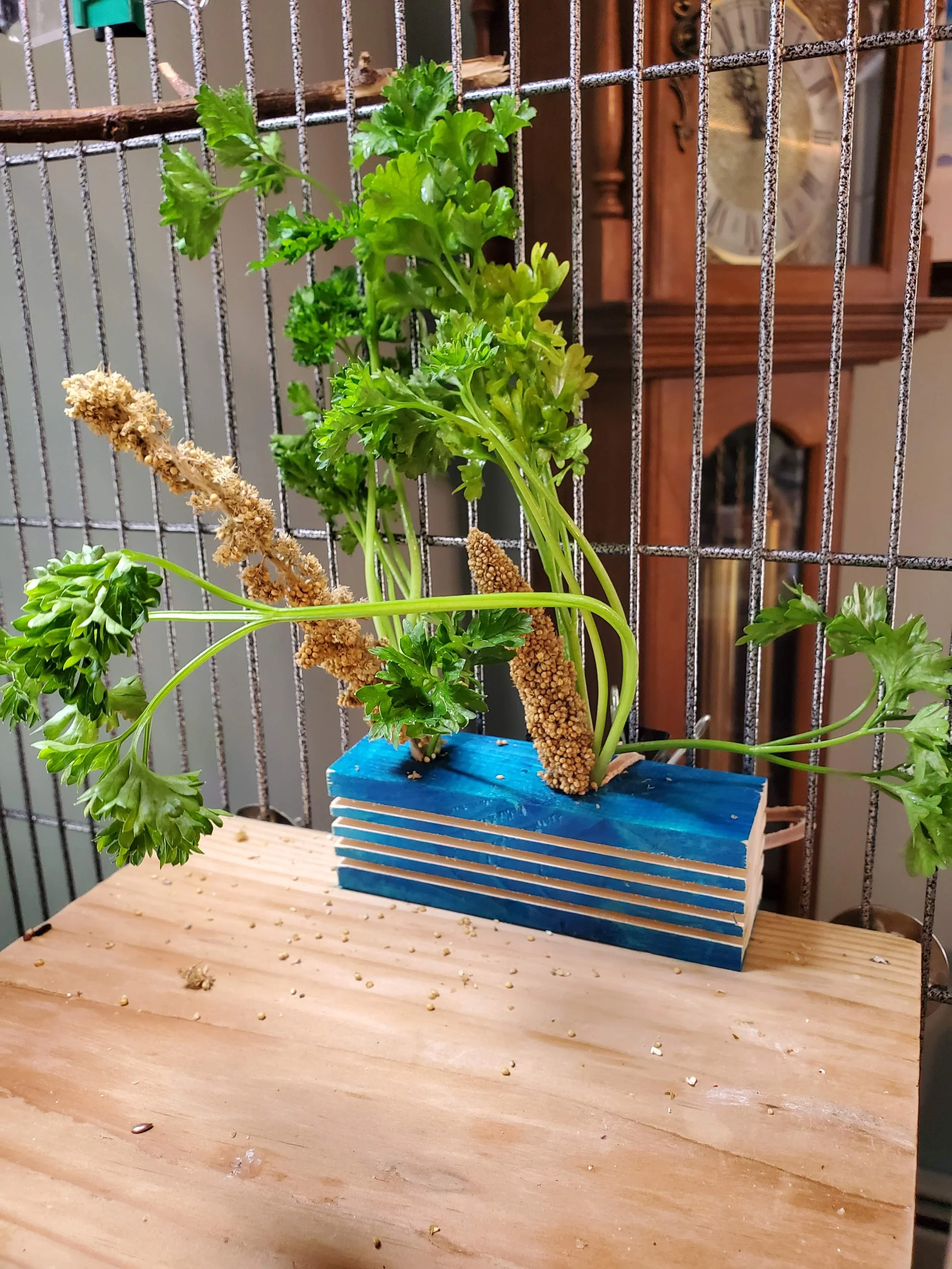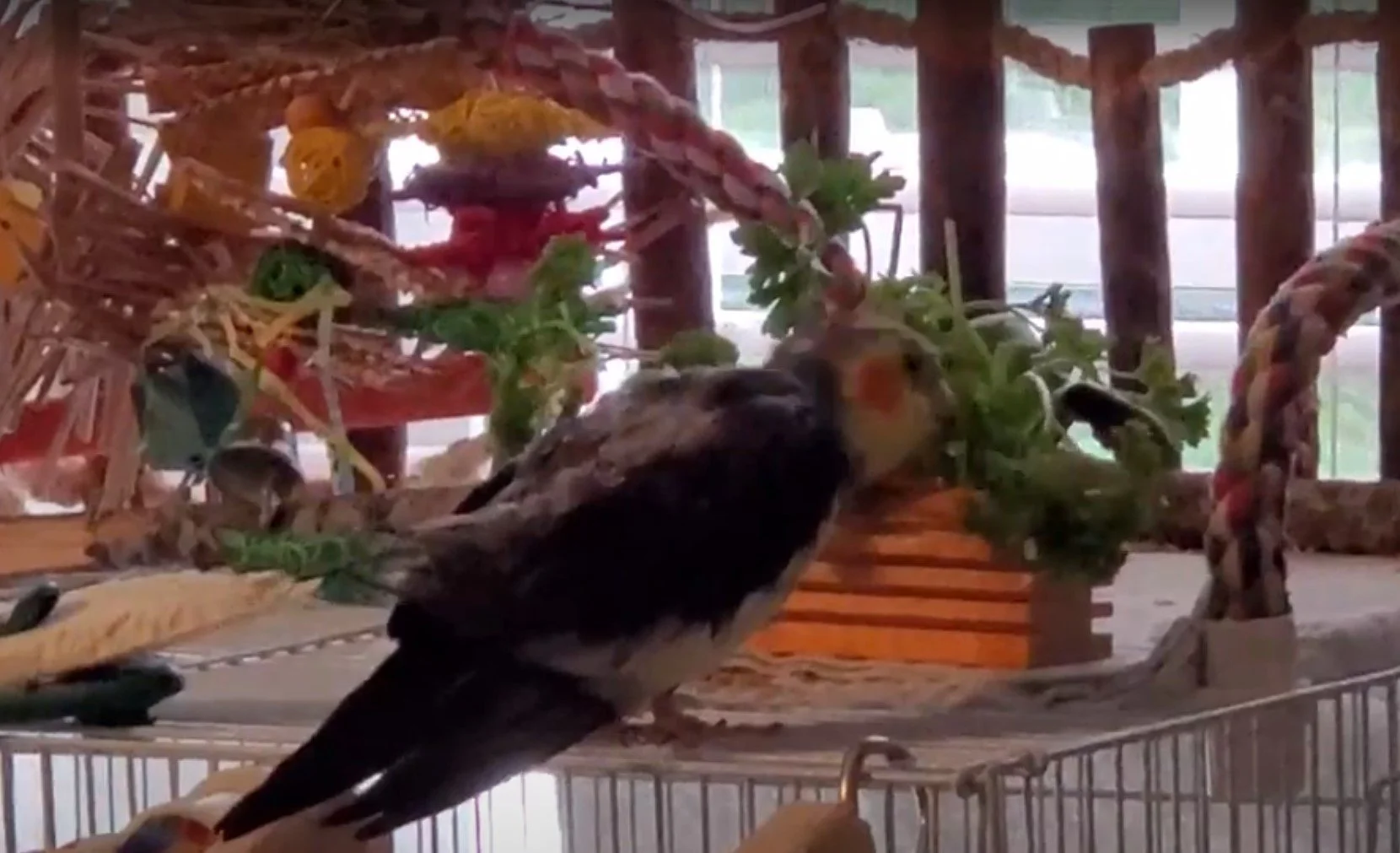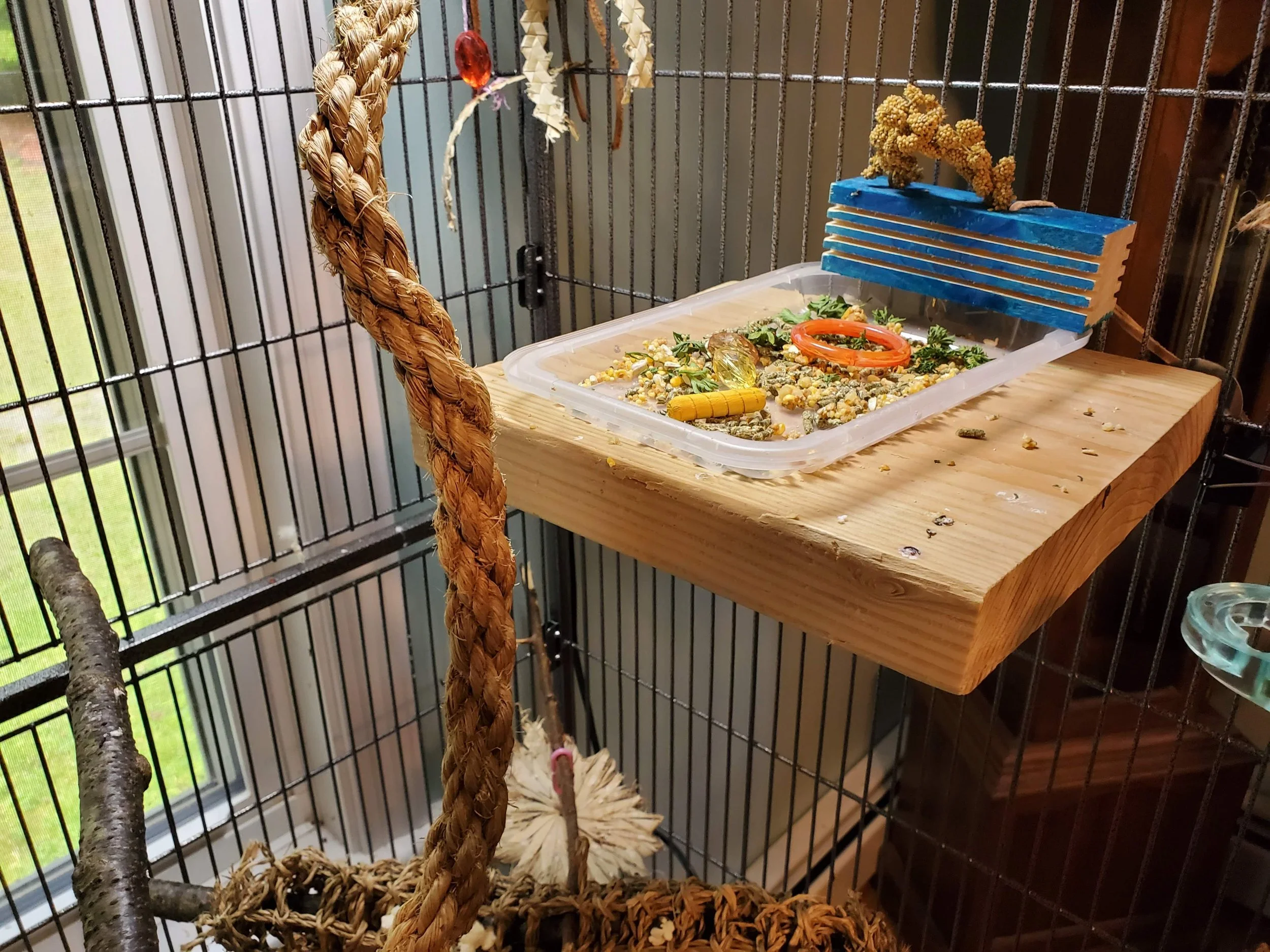Edible Foraging Fun for Companion Birds
By Sheila S. Blanchette, IAABC-CPBC, UW-AAB, Director of Education, Rhode Island Parrot Rescue
In my previous blog, I introduced the concept of foraging for our companion birds (Introduction to Foraging for our Companion Birds). Recently, I highlighted an important concern during a recent presentation on foraging: our companion birds are becoming couch potatoes. Instead of engaging in natural foraging behaviors, these birds now depend on humans to deliver and place their food directly into their food bowls in their enclosures—ie, "DoorDash" service for companion birds.
The Importance of Foraging
Foraging is much more than just a way to feed our companion birds. It can become an adventure that stimulates their minds and supports overall well-being. Engaging in foraging activities enables the companion birds to express their instincts and fulfill essential behavioral needs that are crucial for their health and well-being.
Challenges in Captivity Research
Research has shown that foraging behavior is a priority for many animal species, including parrots (Osborne, 1977; Hughes & Duncan, 1988; Inglis et al., 1997, 2001). Parrots often demonstrate a willingness to work for their food, even when identical food is freely accessible—a phenomenon known as "contrafreeloading" (Coulton et al., 1997; Smith et al., 2021). These birds are motivated to access foraging enrichment, actively seeking opportunities to engage with their environment (Rozek & Millam, 2011; van Zeeland, 2013).
Studies suggest that parrots possess an intrinsic motivation to put effort into acquiring and handling food items (Rozek et al., 2010; James et al., 2021). This motivation is shaped by their diet, ecology, and evolutionary history (Gygax & Hillmann, 2018). The predominantly granivorous diet of parrots requires considerable exploration and manipulation of food using their beak, tongue, and feet—a behavior known as podomandibulation (Rozek et al., 2010; Rozek & Millam, 2011; van Zeeland et al., 2013; James et al., 2021; Mellor et al., 2021).
Unfortunately, captive environments often lack the opportunities needed to satisfy these important foraging behaviors (Hughes & Duncan, 1988; van Zeeland et al., 2009; Rodríguez-Lopez, 2016). While wild parrots typically spend between four and eight hours each day foraging—with activity peaks in the early morning and late afternoon (Gilardi & Munn, 1998; Symes & Perrin, 2003; Salinas-Melgoza & Renton, 2005; O’Hara et al., 2019)—captive parrots may spend less than one hour per day foraging.1
Beyond the Food Bowl
It is perfectly fine to have specific, editable items in your companion bird’s food bowl. If you are typically placing one Nutrberry, or maybe two walnut pieces, or three pistachios because your companion bird expects them, or the companion bird needs them to eat their breakfast or dinner, it is time to introduce some variety. Start mixing things up and teach your companion bird to find those “desired" items on their own.
In my previous blog, I introduced the concept of foraging for our companion birds (Introduction to Foraging for our Companion Birds). I explained how to start with the food bowl. Now, it is time to move to the next step.
It is time to move away from the food bowl.
Stationary Foraging Starter
The Block Tree
a) One Balsa wood (or harder wood block, depending on your companion bird) with predrilled holes
b) Curley Parsley
c) Millet or a piece of avicake
d) Polyrope or untanned leather stripe
Instructions:
I. Laying the balsa wood flat with the holes pointing upward
II. Cut the curly parsley into the holes (like small branches
III. Intertwine the millet with the curly parsley or press avicake around the holes (holding the parsley in place).
IV. Tie the rope or stripe around the block to hold it in place in the cage.
The Treasure Chest
a) A plastic container top (shallow container)
b) Curley Parsley or lettuce
c) Nutraberry, avicake, or companion bird’s favorite food
d) Polyrope or untanned leather stripe
e) Small toy parts
Instructions:
I. In a clean plastic container top, place a small hole in one of the edges, so you can use the polyrope or untanned leather strip to tie to the cage.
II. Add crumbled avicake or nutraberries or companion birds’ favorite food items
III. Place a small amount of curly parsley and a couple of small toy parts
IV. Place the container at the top of cage (if your companion bird can be out of the cage) or tie to the bottom of the cage for your companion bird to root around in. (If your companion bird does not go to the bottom of the cage, you can buy a wooden platform and place the container on the platform (see printscreen).
The Treasure Chest
The Squash Fun
a) A plastic container top (shallow container)
b) Chopsticks
c) Summer Squash, small pumpkin, or small squash
d) Binder clip
Instructions:
I. Clean the squash
II. Cut the top and bottom off
III. Cut a small square, not all the way through. Make a small window so the seeds can be seen.
IV. Place the chopstick through the squash (near the top) so it almost looks like a perch from the front and back
V. Add the few food items in the small window
VI. Place the squash in the plastic container and add a few food items to the container
VII. Place the container at the top of cage (if your companion bird can be out of the cage) or tie to the bottom of the cage for your companion bird to root around in. (If your companion bird does not go to the bottom of the cage, you can buy a wooden platform and place the container on the platform (see printscreen).
When your companion bird has had fun with the stationary Foraging fun, try the movable foraging starter ideas.
Moveable Foraging Starter
The Hanging Rice Cake
a) One clean wooden chopstick
b) One unsalted, no-flavored rice cake
c) One or two binder clips
d) A blueberry
Instructions:
I. Select one unsalted and unfavored rice cake, and using a knife with a point, make a small hole in the center of the rice cake. Go slow when using the knife, as the rice cake can split. If you have a metal straw, you can use it to poke a hole in the center of the rice cake as well.
II. Slide the wooden chopstick through the hole in the rice cake.
III. To keep the rice cake from falling off the chopstick, you can either place a blueberry on the tip of the chopstick or use a binder clip.
IV. Hang the chopstick by placing the chopstick in the cage, and the binder clip is outside of the cage (at the top of the cage). The binder clip clips onto the bar at the top of the cage, and slip the chopstick into the binder.
The Hanging Pepper Ricecake
a) One clean wooden chopstick
b) One unsalted, no-flavored rice cake
c) A small, sweet pepper
d) Popcorn, nutraberry, or companion bird’s favorite food
e) One or two binder clips
f) A blueberry
Optional: a small piece of balsa wood
Instructions:
I. Select one unsalted and unfavored rice cake, and using a knife with a point, make a small hole in the center of the rice cake. Go slow when using the knife, as the rice cake can split. If you have a metal straw, you can use it to poke a hole in the center of the rice cake as well.
II. Cut the top off the small, sweet pepper, remove the seeds, and make a small hole in the bottom of the pepper.
III. Slide the wooden chopstick through the hole in the rice cake, and then slide the pepper through the chopstick. (Optional piece of balsa wood between the rice cake and the small pepper for better balance)
IV. To keep the rice cake from falling off the chopstick, you can either place a blueberry on the tip of the chopstick or use a binder clip.
V. Place a piece of popcorn, a nut, a nutraberry, or the companion bird’s favorite food into the pepper
VI. Hang the chopstick by placing the chopstick in the cage, and the binder clip is outside of the cage (at the top of the cage). The binder clip clips onto the bar at the top of the cage, and slip the chopstick into the binder.
If your companion bird is not comfortable with hanging items, you can attach the hanging items to the side of the cage.
As you observe how your companion bird interacts with these new objects, you can modify them to resemble foods your bird prefers. It may take some time for your bird to get used to the new foraging activities, so be patient and do not give up. You can simplify the setup until your bird begins to explore.
The aim of these foraging items is to keep your bird active and engaged. Prevent them from predicting when food arrives and encourage them to forage rather than be inactive. Enjoy creating the foraging item and let your imagination run wild.
References
1 M.H.C. Beekmans, C.M. Vinke, A. Maijer, I. de Haan, N.J. Schoemaker, T.B. Rodenburg, H.S. Kooistra, Y.R.A. van Zeeland, Increasing foraging times with appetitive and consummatory foraging enrichment in grey parrots (Psittacus erithacus), Applied Animal Behaviour Science, Volume 265, 2023,105986, ISSN 0168-1591,https://doi.org/10.1016/j.applanim.2023.105986.
Copyrighted. Blog posts may be used as guidelines for the proper care of your parrot. Not intended for medical or legal advice. Please consult with a licensed avian veterinarian regarding the medical care and wellbeing of your exotic pets.









